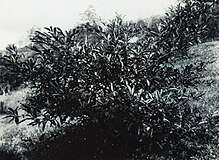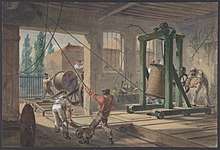Gutta-percha

Gutta-percha refers to trees of the genus Palaquium in the family Sapotaceae and the rigid natural latex produced from the sap of these trees, particularly from Palaquium gutta.
The word gutta-percha comes from the plant's name in Malay, getah perca, which translates as "percha latex".
Description

Palaquium gutta trees are 5–30 m tall and up to 1 m in trunk diameter. The leaves are evergreen, alternate or spirally arranged, simple, entire, 8–25 cm long, glossy green above, and often yellow or glaucous below. The flowers are produced in small clusters along the stems, each flower with a white corolla with four to seven (mostly six) acute lobes. The fruit is an ovoid 3– to 7-cm berry, containing one to four seeds; in many species, the fruit is edible.
In Australia, gutta-percha is a common name specifically used for the euphorbiaceous tree Excoecaria parvifolia, which yields an aromatic, heavy, dark-brown timber.
Chemistry

Chemically, gutta-percha is a polyterpene, a polymer of isoprene, or polyisoprene, specifically (trans-1,4-polyisoprene). The cis structure of polyisoprene is the common latex elastomer. While latex rubbers are amorphous in molecular structure, gutta-percha (the trans structure) crystallizes, leading to a more rigid material.
Historical uses

Scientifically classified in 1843, it was found to be a useful natural thermoplastic. In 1851, 30,000 long cwt (1,500,000 kg) of gutta-percha was imported into Britain.[1]
During the second half of the 19th century, gutta-percha was used for myriad domestic and industrial purposes,[2] and it became a household word. In particular, it was needed as insulation for underwater telegraph cables,[1] which, according to author John Tully, led to unsustainable harvesting and a collapse of the supply.[3]
According to Harvey Wickes Felter and John Uri Lloyd's Endodontology: "Even long before Gutta-percha was introduced into the western world, it was used in a less processed form by the natives of the Malaysian archipelago for making knife handles, walking sticks and other purposes. The first European to discover this material was John Tradescant, who collected it in the far east in 1656. He named this material “Mazer wood”. Dr. William Montgomerie, a medical officer in Indian service, introduced gutta-percha into practical use in the West. He was the first to appreciate the potential of this material in medicine, and he was awarded the gold medal by the Royal Society of Arts, London in 1843."[4]
Electrical
Gutta-percha latex is biologically inert, resilient, and is a good electrical insulator with a high dielectric strength. The wood of many species is also valuable.
Western inventors discovered the properties of gutta-percha latex in 1842, although the people of its Malayan habitat had used it for many applications for centuries. Allowing this fluid to evaporate and coagulate in the sun produced a latex which could be made flexible again with hot water, but which did not become brittle, unlike rubber prior to the discovery of vulcanization.
By 1845, telegraph wires insulated with gutta-percha were being manufactured in the UK. It served as the insulating material for early undersea telegraph cables, including the first transatlantic telegraph cable.[5] Gutta-percha was particularly suitable for this, as it was not attacked by marine plants or animals, which had disabled previous undersea cables. The material was a major constituent of Chatterton's compound used as an insulating sealant for telegraph and other electrical cables.
Since about 1930, polyethylene has supplanted gutta-percha as an electrical insulator.
Other
In the mid-19th century, gutta-percha was also used to make furniture, notably by the Gutta-Percha Company (established in 1847).[1] Several of these ornate, revival-style pieces were shown at the 1851 Great Exhibition in Hyde Park, London. When hot it could be moulded into furniture, decorations or utensils.
It was also used to make "mourning" jewelry, because it was dark in color and could be easily molded into beads or other shapes. Pistol hand grips and rifle shoulder pads were also made from gutta-percha, since it was hard and durable, though it fell into disuse when plastics such as Bakelite became available. Gutta-percha found use in canes and walking sticks, as well.[6]
The material was adopted for other applications. The "guttie" golf ball (which had a solid gutta-percha core) revolutionized the game. Gutta-percha remained an industrial staple well into the 20th Century, when it was gradually replaced with superior (generally synthetic) materials, though a similar and cheaper natural material called balatá is often used in gutta-percha's place. The two materials are almost identical, and balatá is often called gutta-balatá.
In 1856, United States Representative Preston Brooks used a cane made of gutta-percha as a weapon in his attack on Senator Charles Sumner.[7]
Current uses
Dentistry
The same bioinertness that made it suitable for marine cables also means it does not readily react within the human body. It is used in a variety of surgical devices and during root canal therapy. It is the predominant material used to obturate, or fill the empty space inside the root of a tooth after it has undergone endodontic therapy. Its physical and chemical properties, including but not limited to its inertness and biocompatibility, melting point,[8] ductility, and malleability, make it important in endodontics,[4] e.g. as gutta-percha points.
Tjipetir blocks
Mysterious blocks, about the size of a chopping-board, bearing the name "Tjipetir" (a plantation in the Dutch East Indies - now Indonesia - operating in the late 19th and early 20th centuries), have been washing up on the beaches of northern Europe for some time through 2013 and 2014.[9] They are believed to be blocks of gutta-percha from the Japanese liner the Miyazaki Maru, which sank 150 miles (241.5 km) west of the Isles of Scilly during WWI.
See also
References
- 1 2 3 Gutta-Percha company
- ↑ Tully, John (2011). The Devil's Milk. NYU Press.
- ↑ Tully, John (2009). "A Victorian Ecological Disaster: Imperialism, the Telegraph, and Gutta-Percha". Journal of World History. 20 (4): 559–579. doi:10.1353/jwh.0.0088. muse.jhu.edu
- 1 2 Harvey Wickes Felter and John Uri Lloyd. "Gutta-Percha-: An Untold Story. Prakesh et al. ~2001 Endodontology". King's American Dispensatory http://www.ibiblio.org/herbmed/eclectic/kings isonandra.html
- ↑ Schlesinger, Henry (2010). The battery how portable power sparked a technological revolution. New York: HarperCollins e-books. ISBN 9780061985294.
- ↑ Caning of Charles Sumner
- ↑ Green, Michael S. (2010). Politics and America in Crisis: The Coming of the Civil War. Santa Barbara, CA: ABC-CLIO. p. 94. ISBN 978-0-313-08174-3 – via Google Books.
- ↑ Yee, Fulton S.; Marlin, Jay; Krakow, Alvin Arlen; Gron, Poul. "Three-dimensional obturation of the root canal using injection-molded, thermoplasticized dental gutta-percha". Journal of Endodontics. 3 (5): 168–174. doi:10.1016/s0099-2399(77)80091-5.
- ↑ "Tjipetir mystery: Why are rubber-like blocks washing up on European beaches?". www.bbc.co.uk. BBC. Retrieved 1 December 2014.
External links
- Germplasm Resources Information Network: Palaquium
- Gutta-percha on the Transatlantic cable site
- The Gutta Percha Company on the History of the Atlantic Cable site
- "The New Philippine Currency". Annual Reports of the War Department for the Fiscal Year Ended June 30, 1903 - Report of the Philippine Commission. VI. Washington, D.C.: U.S. Government Printing Office. 1904. pp. 388–411. OCLC 220674586.